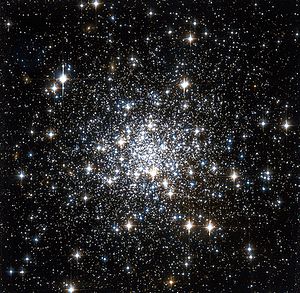NGC 2298
| Kugelsternhaufen NGC 2298 | |
|---|---|
 | |
| Hubble-Aufnahme von NGC 2298 | |
| AladinLite | |
| Sternbild | Achterdeck des Schiffs |
| Position Äquinoktium: J2000.0, Epoche: J2000.0 | |
| Rektaszension | 06h 48m 59,2s [1] |
| Deklination | −36° 00′ 19″ [1] |
| Erscheinungsbild | |
| Konzentrationsklasse | VI [2] |
| Helligkeit (visuell) | 9,3 mag [3] |
| Winkelausdehnung | 5′,0 [4] |
| Physikalische Daten | |
| Zugehörigkeit | Milchstraße (Canis-Major-Zwerggalaxie) |
| Rotverschiebung | +0,000498 ± 0,000004 [5] |
| Radialgeschwindigkeit | (+149,4 ± 1,3) km/s [5] |
| Entfernung | 26960 ± 2470 Lj [6] |
| Absolute Helligkeit | −6,3 mag [7] |
| Durchmesser | 55 Lj |
| Alter | (13,2 ± 0,4) Mia. Jahre [8] |
| Metallizität [Fe/H] | −1,92 [8] |
| Geschichte | |
| Entdeckung | James Dunlop |
| Entdeckungsdatum | 8. Mai 1826 |
| Katalogbezeichnungen | |
| NGC 2298 • C 0647-359 • GCl 11 • ESO 366-SC22 • Dun 578 • GC 1463 • h 3065 | |
NGC 2298 ist ein Kugelsternhaufen im Sternbild Puppis und hat eine Winkelausdehnung von 6′,8 und eine scheinbare Helligkeit von 9,3 mag. Der Kernradius beträgt 16″,3, die Flächenhelligkeit 18,7 mag/arcsec2 [9].
Der Sternhaufen wurde am 8. Mai 1826 von James Dunlop entdeckt.[10]
Literatur
[Bearbeiten | Quelltext bearbeiten]- König, Michael & Binnewies, Stefan (2023): Bildatlas der Sternhaufen & Nebel, Stuttgart: Kosmos, S. 362
Einzelnachweise
[Bearbeiten | Quelltext bearbeiten]- ↑ NASA/IPAC EXTRAGALACTIC DATABASE
- ↑ Harlow Shapley, Helen B. Sawyer: A Classification of Globular Clusters. In: Harvard College Observatory Bulletin. Band 849, 1927, S. 11–14, bibcode:1927BHarO.849...11S.
- ↑ van den Bergh et al.: "Diameters of Galactic globular clusters"; in: Astrophysical Journal, Vol. 375, S. 594ff. bibcode:1991ApJ...375..594V
- ↑ SEDS: NGC 2298
- ↑ SIMBAD-Datenbank
- ↑ Dinescu et al.: "Space Velocities of Globular Clusters. III. Cluster Orbits and Halo Substructure"; in: The Astronomical Journal, Vol. 117, Issue 4, S. 1792ff. bibcode:1999AJ....117.1792D
- ↑ Forbes et al.: "The Globular Cluster System of the Canis Major Dwarf Galaxy"; in: The Astronomical Journal, Vol. 127, Issue 6, S. 3394ff. bibcode:2004AJ....127.3394F
- ↑ a b M. Salaris, A. Weiss: "Homogeneous age dating of 55 Galactic globular clusters. Clues to the Galaxy formation mechanisms."; in: Astronomy and Astrophysics, Vol. 388, S. 492ff. bibcode:2002A&A...388..492S
- ↑ E. Noyola, K. Gebhardt: "Surface Brightness Profiles of Galactic Globular Clusters from Hubble Space Telescope Images"; in: The Astronomical Journal, Vol. 132, Issue 2, S. 447ff. bibcode:2006AJ....132..447N
- ↑ Seligman